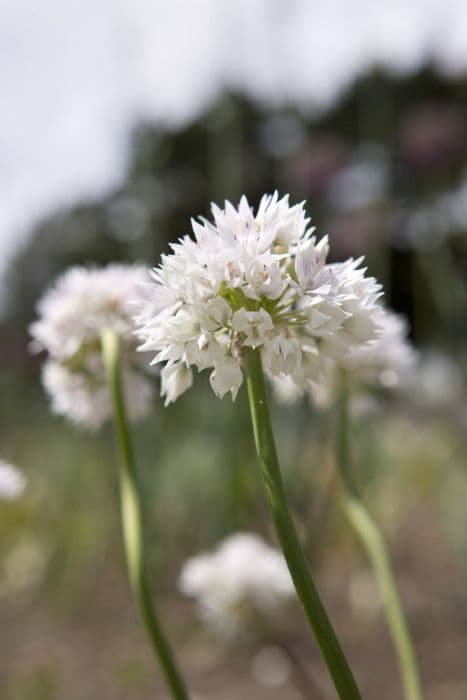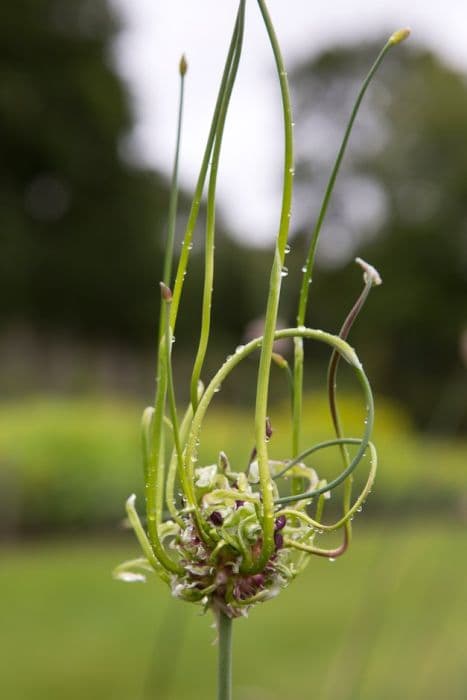Twistedleaf Garlic Allium obliquum

ABOUT
The plant known as twistedleaf garlic features a striking appearance that is easily recognizable to those familiar with ornamental alliums. The standout character of this plant is its elongated, lance-shaped leaves that twist artistically as they grow, often creating a mesmerizing effect. The leaves are a vibrant green, adding a fresh splash of color to the garden scape. During its blooming period, twistedleaf garlic produces globular clusters of attractive flowers. These blossoms tend to be a soft, luminous yellow, giving off a gentle and warm aesthetic. The flowers are compact, closely set, and star-shaped, which affords the clusters a textured, almost spiky look. These floral spheres are typically borne atop sturdy, upright stems which are also green, seamlessly integrating with the foliage. While the growth habit of twistedleaf garlic is relatively compact, it's the shape and form of its leaves and flower clusters that set it apart from other garden plants, giving it a distinctive sculptural quality. As an ornamental, this plant is valued for its ability to provide visual interest through its unique foliage and cheery floral displays.
About this plant
 Names
NamesFamily
Amaryllidaceae
Synonyms
Twistedleaf Garlic, Twist-leaf Garlic
Common names
Allium obliquum L., Cepa obliqua (L.) Moench, Codonoprasum obliquum (L.) Rchb.
 Toxicity
ToxicityTo humans
Allium obliquum, commonly known as twisted-leaf garlic, is not considered toxic to humans. Indeed, many species of the genus Allium are cultivated and widely consumed for their culinary uses, such as onions, garlic, leeks, and chives. As with any plant, individual allergies or sensitivities may exist, and consuming large quantities could potentially lead to gastrointestinal discomfort or other common food-related issues. However, in general, twisted-leaf garlic does not pose a risk of poisoning when ingested by humans.
To pets
Twisted-leaf garlic is toxic to pets, especially cats and dogs. Allium obliquum, like other members of the Allium family, contains compounds that can be harmful to animals if ingested in significant quantities. The consumption of this plant can lead to Allium poisoning in pets, which can cause symptoms such as vomiting, diarrhea, abdominal pain, loss of appetite, and lethargy. In more severe cases, ingestion can result in damage to red blood cells, leading to hemolytic anemia. This condition is characterized by symptoms such as pale gums, rapid breathing, an elevated heart rate, weakness, and collapse. Immediate veterinary attention is recommended if a pet consumes any part of this plant.
 Characteristics
CharacteristicsLife cycle
Perennials
Foliage type
Deciduous
Color of leaves
Green
Flower color
Yellow
Height
1-2 feet (30-60 cm)
Spread
1 foot (30 cm)
Plant type
Bulb
Hardiness zones
4
Native area
Asia
Benefits
 General Benefits
General Benefits- Culinary Uses: The twisted onion, as Allium obliquum is commonly known, has edible parts that can be used in cooking for their distinctive flavor.
- Ornamental Value: With its bright yellow flowers and unusual twisted stems, the twisted onion is an attractive addition to gardens and landscapes.
- Pollinator Attraction: The flowers of Allium obliquum attract bees and other pollinators, promoting biodiversity in the garden.
- Companion Planting: The twisted onion can be beneficial in a garden when planted alongside other crops as it may help to deter certain pests.
- Low Maintenance: It is relatively easy to care for, requiring minimal upkeep once established in suitable conditions.
- Edible Landscaping: The plant can be incorporated into edible landscaping, where every plant in a garden has a dual purpose of being both ornamental and edible.
 Medical Properties
Medical Properties- Antimicrobial: Allium obliquum is known to have antimicrobial properties that help in fighting against various bacteria and fungi.
- Antioxidant: Contains compounds that can act as antioxidants, helping to protect the body from oxidative stress and damage from free radicals.
- Anti-inflammatory: May possess anti-inflammatory effects that can help in reducing inflammation in the body.
- Cardiovascular health: Compounds in this plant might contribute to cardiovascular health by promoting better blood lipid profiles.
 Air-purifying Qualities
Air-purifying QualitiesThis plant is not specifically known for air purifying qualities.
 Other Uses
Other Uses- Allium obliquum, commonly known as twisted-leaf garlic, can be used as a natural pest repellent in gardens due to its strong scent that deters many insects and browsing animals.
- The plant is sometimes used in floral arrangements for its distinctive twisted leaves and attractive yellow-green flower heads, adding unique texture and form.
- The stems of twisted-leaf garlic can be woven into baskets or other crafts for their flexibility and strength when harvested at the right time.
- The juice extracted from the plant has been traditionally used as a natural dye for fabrics, providing a range of green hues.
- Allium obliquum can serve as a companion plant in vegetable gardens, potentially improving the growth and taste of certain vegetables like tomatoes and carrots.
- The plant's ability to adapt to various soil types makes it a suitable choice for erosion control on slopes and banks.
- Culinary artists sometimes use the blossoms of twisted-leaf garlic as an edible decoration to add both flavor and visual appeal to dishes.
- The plant's attractive appearance makes it a popular choice for ornamental gardens, rock gardens, and as border plants.
- When dried, the seed heads of Allium obliquum can be used in craft projects or as long-lasting additions to dry flower arrangements.
- Ecologically, twisted-leaf garlic provides nectar for pollinators such as bees and butterflies while also serving as a host plant for their larvae.
Interesting Facts
 Feng Shui
Feng ShuiThe plant Allium obliquum, commonly known as twisted-leaf garlic, is not typically used in Feng Shui practice.
 Zodiac Sign Compitability
Zodiac Sign CompitabilityTwisted-leaf garlic is not used in astrology practice.
 Plant Symbolism
Plant Symbolism- Perseverance and Strength - Allium obliquum, commonly known as twisting onion, often symbolizes the ability to withstand adversity and remain strong due to its robust nature and ability to thrive in various conditions.
- Unity and Patience - The tightly clustered blossoms of the twisting onion represent individuals coming together in unity, and its growth habit signifies the importance of patience in achieving collective goals.
- Healing and Protection - Historically, alliums have been used for their medicinal properties, so twisting onion can symbolize healing. It is also thought to ward off evil spirits or negative energies, offering protection.
- Good Fortune - In some cultures, alliums are believed to bring luck or good fortune to those who plant them or keep them in their homes, so twisting onion can carry this connotation as well.
 Water
WaterThe twisted-leaf garlic should be watered moderately. Initially, water this perennial once a week, providing about 1 to 1.5 gallons per square yard of soil. During the growing season, ensure the soil remains moist but not waterlogged. If there's a dry spell or unusually hot weather, you might need to water twice a week. However, once established, twisted-leaf garlic is somewhat drought tolerant and may require less frequent watering, particularly if there has been adequate rainfall.
 Light
LightTwisted-leaf garlic prefers full sun to partial shade. It's best situated in a location where it can receive at least six hours of sunlight daily. However, if you are in a region with very harsh afternoon sun, providing some light afternoon shade will help prevent potential damage to the foliage.
 Temperature
TemperatureTwisted-leaf garlic thrives in temperatures between 55°F and 75°F but can endure temperatures as low as 20°F and as high as 80°F. Protect the plant from extremes by providing mulch in winter to lessen the impact of frost, and ensure good air circulation to prevent overheating in summer.
 Pruning
PruningPruning twisted-leaf garlic isn't necessary for health but can be done to remove spent flower stalks and to tidy up the appearance of the plant. Deadheading, or the removal of old flower heads, may encourage the plant to focus its energy on producing more foliage. The best time for pruning is after flowering when you can remove the flower stalks at their base to keep the plant neat.
 Cleaning
CleaningAs needed
 Soil
SoilThe Twistleaf Onion thrives in well-draining soil with a mix of loam, sand, and compost; it prefers a soil pH of 6.0 to 8.0.
 Repotting
RepottingTwistleaf Onion should be repotted every 2-3 years to refresh the soil and accommodate growth.
 Humidity & Misting
Humidity & MistingTwistleaf Onion is tolerant of a wide range of humidity conditions and does not have specific humidity requirements.
 Suitable locations
Suitable locationsIndoor
Place in bright light, well-draining soil mix, and room temperature.
Outdoor
Plant in full sun to partial shade, well-draining soil.
Hardiness zone
4-8 USDA
 Life cycle
Life cycleAllium obliquum, commonly known as twistedleaf garlic, begins its life cycle with seed germination, typically in early spring, after experiencing cold stratification which breaks seed dormancy. The seedlings develop a bulb at the base and slender, grass-like leaves. In the following seasons, the perennial bulb grows larger and produces more leaves, gathering energy through photosynthesis. Flowering occurs in late spring or early summer, producing an umbel of yellowish-green or pinkish flowers atop a leafless stem that often bends or twists (hence the common name). After pollination, usually by insects, the flowers develop into seed capsules containing black seeds, which are eventually dispersed nearby. The mother plant may die back after seeding, but the bulbs remain dormant underground during the winter to restart the cycle in the following spring.
 Propogation
PropogationPropogation time
Spring-early summer
Allium obliquum, commonly known as twisted-leaf garlic, is typically propagated by means of bulb division, which is a simple and effective method. The best time to carry out this process is during the plant's dormant period, usually in late summer to autumn, after the foliage has died back. To propagate by bulb division, carefully dig up the clump of bulbs and gently separate them by hand, making sure that each new section has at least one growth point or shoot. These individual bulbs can then be replanted immediately, at a depth approximately twice the diameter of the bulb, spaced about 6 to 8 inches apart (15 to 20 cm) to allow room for growth. Within a year or two, these bulbs will mature and can potentially produce flowers, carrying on the cycle of growth for twisted-leaf garlic.








